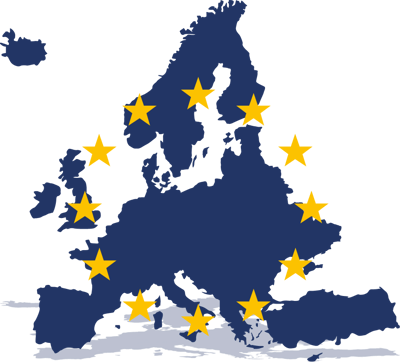
1StopVAT explains current EU VAT rules in this guest article.
The European Union introduced a significant VAT reform on July 1, 2021, that made the VAT compliance challenges for EU and non-EU taxable persons less costly and fragmented. Adopting the reform brought much-needed transparency regarding the determination of the place of supply and tax treatment for different kinds of supplies. It has also reduced the number of scenarios that trigger mandatory registration in one or more Member States.
Taxable persons within the European Union and those established beyond the EU can benefit from introducing the One-Stop-Shop simplified scheme. Most digital vendors operating with end customers based in the EU can benefit from these schemes. In this article, we’ll explain how the simplified system works.
Simplified Tax Reporting
 The introduction of the simplified tax reporting tool permits suppliers from EU and non-EU countries to collect VAT owed to the different Member States into one OSS return and submit it quarterly through the web portal of their Member state of identification.
The introduction of the simplified tax reporting tool permits suppliers from EU and non-EU countries to collect VAT owed to the different Member States into one OSS return and submit it quarterly through the web portal of their Member state of identification.
The scope of the One-Stop-Scheme is pretty extensive, and depending on the tax residence of the supplier in question, it covers business-to-consumer (B2C) cross-border supply of goods, B2C intra-community supply of services, and B2C supply of low-value goods imported from third countries or third territories to EU based customers.
From a practical perspective, it means that eligible suppliers who can register for the OSS scheme can:
- Eliminate or reduce the necessity to be VAT registered in the country(s) where the tax is due.
- Aggregate all their eligible B2C supplies in one return.
- Submit the return through the online portal of the Member State of ID and pay the tax owed accordingly.
- The European Commission central system will then distribute the VAT credit accordingly to Member State(s).
The positive outcome is straightforward. Taxable persons have radically reduced the need to be registered in several Member States due to the place of supply rules. This results in less headache over VAT compliance challenges, less cost for tax representation in different countries, and, most importantly, more time to focus on business growth and revenue generation.
The changes affect everyone included in the supply chain of online commerce. So, it goes beyond online merchants; it covers digital marketplaces, consumers, national tax administrations, and customs operators.
Advantages and Requirements of the E-Commerce VAT Package
Threshold
The adoption of the e-commerce package also addressed the country-based thresholds defined per member state regarding the supply to customers based within the respective country. Country-based thresholds became absolute.
The established threshold covers not just intra-community distance sales of goods; it includes cross-border B2C sales of telecommunications, broadcasting, and electronic services for determining the place of supply.
EU-based suppliers may opt for the advantage guaranteed by the applicability of the threshold when their EU sales to final customers (B2C) are below EUR 10,000. In those circumstances, the place of supply will be the place of their residence.
Non-EU sellers can’t benefit from the usage of this threshold. For them, different rules apply when determining the place of the supply.
Suppliers
The introduction of the One Stop Shop Scheme for EU B2C cross-border supply of goods and services made things much easier for online suppliers. Online merchants, e-retailers, digital marketplaces, and platforms now have this highly beneficial system.
They can accumulate all their B2C EU cross-border sales of goods and services (following the specific requirements), declare all their sales, and pay tax using one or more OSS special schemes.
The introduction of the OSS schemes drastically reduced the number of situations when taxable persons must register in more than one Member State by default. However, it doesn’t mean that the supplier will not be obliged to follow the procedure for VAT registration in more than one EU country, even while benefiting from the registration to the OSS system.
Many more conditions could trigger the mandatory obligation for the supplier to move forward with the registration procedure in the Member State where it sells and stocks its goods.
OSS Schemes
Three types of simplifying reporting schemes exist within the One Stop Shop system.
Non-EU OSS Scheme
The non-EU-based suppliers are the ones who could take leverage from this scheme. The registration for this scheme permits sellers who are not tax residents or are not established in the EU to declare all their EU cross-border sales of services with one return.
The suppliers must obtain an EU VAT number to benefit from this scheme. They can choose what Member State will become their Member State of identification.
EU OSS Scheme
EU and non-EU-based suppliers can both benefit from this particular scheme. However, there is an essential difference regarding what category of supplies can be declared based on the tax residence of the seller in question.
The EU-based suppliers can declare:
- Intra-community B2C supplies of services
- Intra-community distance sales of goods
- Domestic B2C supplies of goods (only applicable to digital marketplaces in specific conditions)
Conversely, the non-EU-based suppliers can benefit from this reporting scheme for declaring all their EU B2C intra-community distance sales of goods.
IOSS Scheme
The Import-One-Stop simplified scheme (or IOSS) is the reporting tool introduced through the E-commerce package of July 2021. It is highly beneficial for both EU and non-EU-based suppliers.
The IOSS scheme permits suppliers that import low-value goods from third countries or third territories in the second stage to sell to end customers and declare all their sales through this scheme.
The online merchant must register for an EU VAT number before benefiting from this scheme.
Digital Marketplaces
Adopting reform brought into reality various obligations to digital marketplaces and platforms operating in the EU. When the digital marketplace meets conditions in some specific situations, it becomes the actual seller from a VAT perspective. In these scenarios, the underlying supplier (actual supplier) transfers VAT compliance duties to a digital platform.
In the digital economy, we see marketplaces and platforms as forefront leaders and game-changing behemoths as the main link in the supply chain of online-supported transactions. When the digital marketplace is the supplier in this business model, it can benefit from using the OSS schemes.
Deemed Supplier Model
The EU VAT Directive stipulates that Digital Platform Operators (taxable persons controlling the platform) will be responsible for VAT in specific cases.
The VAT responsibilities should pass from the underlying supplier (actual seller) to the platform operator, and the platform is treated as an actual supplier. From the practical standpoint, the digital platform assumes the responsibility for accurate charge, collection, and tax remittance.
The digital marketplace bears the responsibility of the deemed supplier by default in two types of cases:
- Distance sales of goods imported from third countries or third territories to the EU with a value not exceeding EUR 150 and/or
- Cross-border EU B2C supplies, irrespective of their value, when the underlying supplier is a non-EU tax resident (domestic supplies and distance sales within the EU are covered).
Looking for EU VAT rules compliance assistance? Contact 1stopVAT and book your first consultation for FREE!





